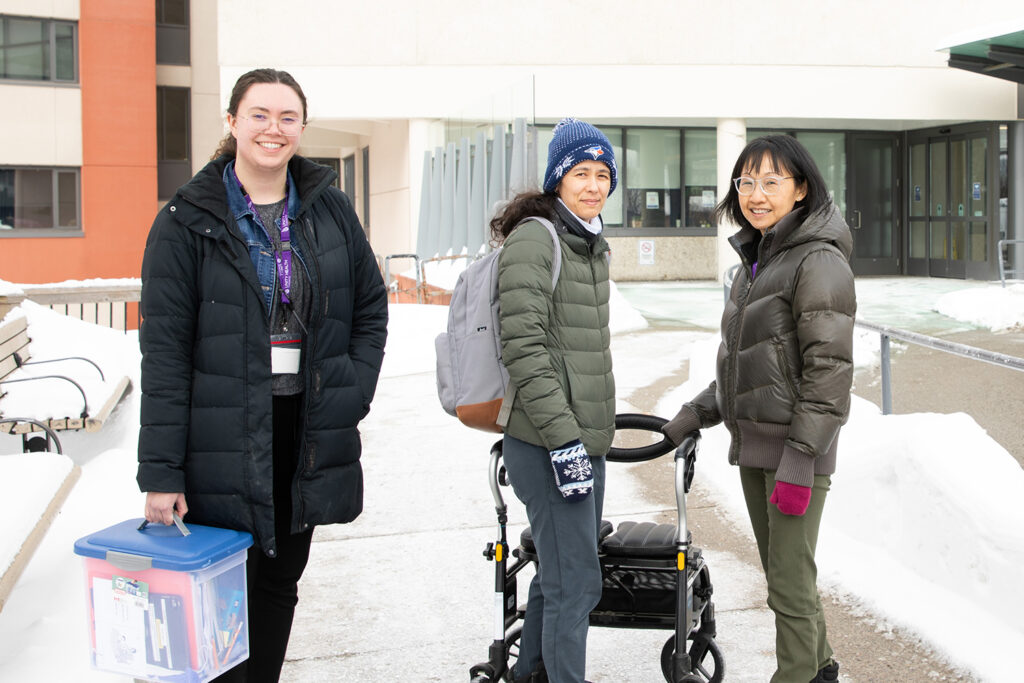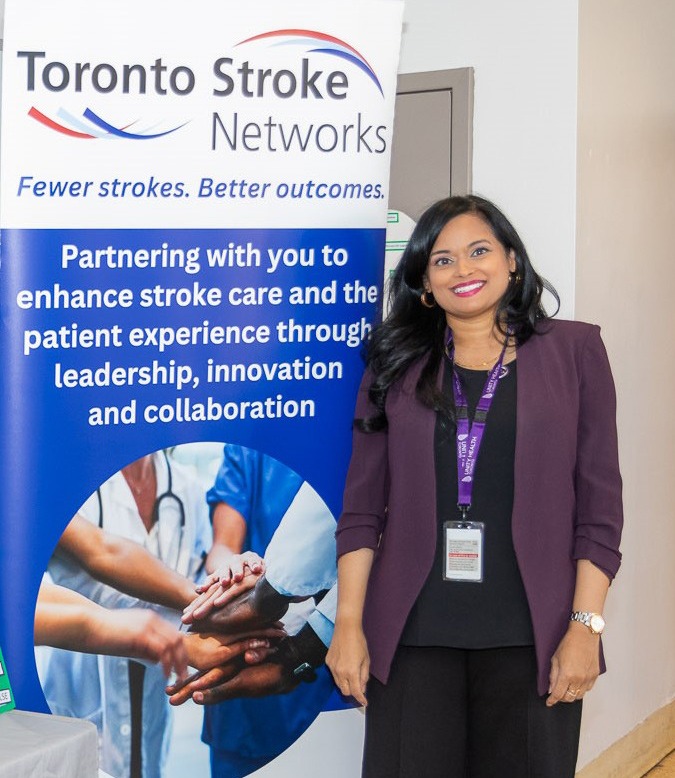New in-home rehabilitation pilot removes barriers for stroke survivors

(Left to right): Kayla Belisle, speech language pathologist, Tanya Sakharov, physiotherapist and Joyce Lee, occupational therapist, make up the team providing specialized stroke rehab to patients in their homes as part of a pilot program.
A new in-home rehabilitation pilot initiative is offering Unity Health Toronto stroke patients the opportunity to receive personalized rehabilitation therapy in the comfort of their own homes.
As healthcare systems grapple with increasing demands, Unity Health’s regional stroke program and Providence Healthcare collaborated to establish an innovative pilot program aimed at bridging gaps in post-stroke care, with Providence leading its planning and implementation. The model not only aims to improve access to stroke rehabilitation, but also to serve a patient population that has been underserved – those who may have lower function, live alone, or have difficulty with transportation.
“There are a lot of patients that miss the opportunity to attend rehab because they just simply can’t access our outpatient setting, whether that’s because of transportation, physical or cognitive function,” says Godfrey Wong, former clinical operations lead for the Stroke & Neuro Clinic at Providence.
Sign up for the Unity Health Toronto newsletter, a monthly update on the latest news, stories, patient voices and research emailed directly to subscribers. If you haven’t subscribed yet, you can do that by clicking here.
“We also considered if patients have goals that can be better achieved in an in-home environment, so looking at supporting care in the home by practicing with the equipment and space they have.”
While in-home rehab services are available through home and community care, stroke rehabilitation requires early access to regular therapy provided by therapists with specialized training and education often not available through the traditional homecare sector. Currently, specialized in-home stroke rehab is only available in one small pocket of the Greater Toronto Area and in some rural parts of Ontario. The team at Unity Health is filling a gap for the Toronto region by forming an in-home stroke care team made up of hospital-based staff who have specialized knowledge in stroke care.
“Providence is well known for its high quality inpatient and outpatient stroke rehab programs, you’ve already got a group of skilled stroke clinicians, so it made sense to pull together a team from within the hospital,” says Fatima Quraishi, regional stroke program director at Unity Health.
“This pilot allows for Unity Health to provide integrated stroke services, which means better continuity of care for the patients. Using a hospital based in-home team provides the benefits of having access to stroke education and supports offered by the larger stroke program at Unity Health, and builds a more flexible and sustainable staffing model.”

The in-home stroke rehab team is made up of an occupational therapist, a physiotherapist and a speech language pathologist. Using learnings from Providence’s specialized geriatric services program that already does home outreach visits, the team developed a 12-week pilot, taking into consideration protocols around home safety, as well as equipment needs.
“I think the in-home program is where occupational therapy really shines because occupation is the day-to-day things, skills or tasks – getting up in the morning, putting your clothes on, making a meal in the kitchen,” says Joyce Lee, occupational therapist from the Stroke Clinic at Providence.
“What’s really exciting is I get to go into patients’ homes and look at ways we can get around certain barriers to these tasks and it’s now part of a very specific, tailored and specialized therapy at home.”
Kayla Belisle, speech language pathologist from the Providence Stroke Clinic, says providing support in an in-home setting has had practical benefits to meeting patients’ unique needs.
“I have noticed with swallowing, for example, it’s been really great because I’ve been able to do a lot of meal assessments actually seeing what a meal would look like day-to-day for them,” she says. “I’ve been able to more easily look at modifications that can be made that will work in the home and are beneficial for each individual.”
For physiotherapist Tanya Sakharov, the home environment has helped her support building patients’ home exercise programs based on the spaces in their homes that are best suited, as well as getting them moving out in their communities where they can practice in their own neighbourhoods, on streets that are familiar to them.
“It does involve a bit of creativity and scanning their environment on the first day,” says Sakharov, physiotherapist in Providence’s stroke clinic. “We have some equipment we bring with us, but you definitely need to think outside of the box when you’re not in a clinic, look at their home environment and see what things you can use. For example, using the arm rest of a couch as an alternate surface for different treatment exercises and as a way to practice sitting to standing when the couch is too low.”
As part of assessing the pilot, Lee, Sakharov, and Belisle leave patients with a survey to provide their feedback. They say it has been positive overall with many remarking on their desire for the program to continue permanently to help others. One patient noted they would not have been able to physically come in for therapy. They said the pilot has been crucial to learning how to safely complete every day tasks, like changing their cat’s litter or washing the dishes.
“I’m so grateful to be a patient in the at home therapy program […] Providence has continued to help me do everyday living,” they wrote.
Quraishi and Wong say they believe the in-home stroke care model can have several benefits to hospital system flow, as well as to patients and their families in helping patients function and stay living in their homes longer after a stroke. The team is continuing to evaluate the pilot and working to make it permanent.
By Danielle Pereira. Photos by Katie Cooper and Yuri Markarov
